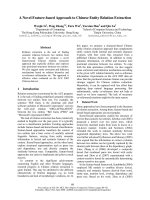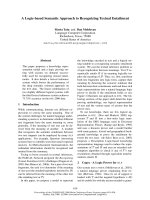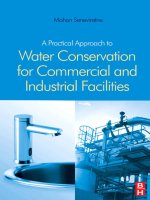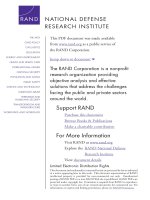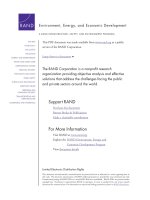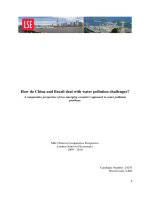A New Institutional Economics Approach To Water Resource Management
Bạn đang xem bản rút gọn của tài liệu. Xem và tải ngay bản đầy đủ của tài liệu tại đây (2.35 MB, 313 trang )
A New Institutional
Economics Approach to
Water Resource
Management
Dhruv Sharma
A thesis submitted in partial fulfilment of the
requirements for the degree of
Doctor of Philosophy
Discipline of Political Economy
Faculty of Economics and Business
University of Sydney
April 2012
Statement of originality
This thesis contains no material which has been presented for a degree at this or any
other university and, to the best of my knowledge and belief, contains no copy or
paraphrase of work published by another person, except where duly acknowledged in
the text.
Dhruv Sharma
i
Acknowledgements
I would like to thank my supervisor, Professor Frank Stilwell, for his invaluable
advice, guidance and encouragement for developing the ideas expressed in this thesis.
Frank’s support throughout my candidature and especially during the recovery stages
of my injury in 2007 is greatly appreciated. With Frank’s guidance and
encouragement I have learned much about the importance of being open-minded and
approaching problems from different perspectives.
My associate supervisor, Dr. Damien Cahill, also has provided invaluable guidance
and encouragement and I would like to thank him for taking the time to provide
detailed feedback on my work.
I would like to thank the Faculty of Economics and Business for providing me with
resources and research facilities during my candidature.
During my candidature I had the opportunity to tutor a variety of courses in three
different disciplines, econometrics, economics and political economy. I would like to
thank Dr. Daniel Oron (Discipline of Operations Management and Econometrics),
Mr. John Goodhew (Discipline of Operations Management and Econometrics),
Dr. David Kim (Discipline of Economics) and Professor Frank Stilwell (Discipline of
Political Economy) for giving me these opportunities. The camaraderie of my fellow
tutors, Franklin, Pat, Lina and Rama made this a memorable and fun experience.
Finally, I like to express my deepest gratitude to my family for firstly, encouraging
me to undertake a PhD and secondly, for unselfishly supporting me throughout my
candidature.
ii
Abstract
Water policy makers around the world currently face the Sisyphean task of managing
water resources that have deteriorated due to overuse and mismanagement. This
thesis focuses on water resource management and places emphasis on the water
policy reform process, with particular reference to Australia’s most important, yet
most problematic, water resource – the Murray-Darling Basin. It emphasises the
importance of institutions in dealing with effective water management and the water
policy reform process. The neo-classical economics approach is limited in its
approach to water resource management. There is scope for alternative,
multidimensional approaches. The new institutional economics tradition offers one
such alternative. It is argued that a new institutional economics approach, combined
with recognition of the challenges of governance, can provide an alternative and
more holistic approach to water resource management.
Using a levels of institutions approach this thesis identifies aspects of the current
approach to management of the Murray-Darling Basin that could be improved. It
identifies the potential for transaction cost reduction in water markets and successful
policy implementation by emphasising the need to focus, alongside economic and
political institutions, on social institutions such as cultural norms and behavioural
attitudes towards water resources. A new institutional economics analytical
framework is used to re-contextualise the water policy debate by centralising the
environment within the policy reform process.
iii
Table of Contents
Abstract........................................................................................................................iii
List of Tables .............................................................................................................viii
List of Figures.............................................................................................................. ix
Map of the Murray-Darling Basin ............................................................................ xi
Part I
Introduction, Theory and Context ............................................................................. 1
Chapter 1 – Introduction and overview ..................................................................... 2
1.1 An Institutionalist Perspective ............................................................................. 2
1.2 Overview of the Main Issues ................................................................................ 6
1.3 Institutions ............................................................................................................ 9
1.4 Neo-classical Economics and Water .................................................................. 12
1.5 Institutional Reform ........................................................................................... 14
1.6 Recent Policy Initiatives..................................................................................... 15
1.7 Thesis Structure .................................................................................................. 17
1.8 A Note on Methodology and Data ..................................................................... 21
1.9 Conclusion.......................................................................................................... 22
Chapter 2 – Theoretical Framework ....................................................................... 24
2.1 Introduction ........................................................................................................ 24
2.2 Institutions and Organisations ............................................................................ 24
2.3 Problems with the Traditional Approach ........................................................... 28
2.4 The Institutional Economics Approach .............................................................. 30
2.5 New Institutional Economics ............................................................................. 34
2.6 Institutional Economics and Water .................................................................... 37
2.7 Conclusion.......................................................................................................... 40
Chapter 3 – The Murray-Darling Basin .................................................................. 42
3.1 Introduction ........................................................................................................ 42
3.2 Features of the Murray-Darling Basin ............................................................... 42
3.3 Murray-Darling Basin Institutions ..................................................................... 49
3.4 The River Murray Waters Agreement and the River Murray Commission ....... 50
3.5 The Murray-Darling Basin Agreement .............................................................. 51
3.6 The Council of Australian Governments ........................................................... 53
iv
3.7 The Living Murray ............................................................................................. 55
3.8 The National Water Initiative ............................................................................. 57
3.9 The National Plan for Water Security ................................................................ 58
3.10 Water for the Future ......................................................................................... 61
3.11 The Basin Plan ................................................................................................. 62
3.12 Key Problems Facing the Murray-Darling Basin............................................. 63
3.13 Conclusion........................................................................................................ 67
PART II
A Levels of Institutions Approach to Water Resource Management ................... 68
Chapter 4 – A Levels of Institutions Analysis ......................................................... 69
4.1 Introduction ........................................................................................................ 69
4.2 Level 2 Institutions – Property Rights and Water Markets ................................ 70
4.3 Levels of Institutions Mapping .......................................................................... 84
4.4 A Levels of Institutions Assessment of Murray-Darling Basin Institutions ...... 87
4.5 Conclusion.......................................................................................................... 98
Chapter 5 – Environmental Sustainability and Economic Growth ...................... 99
5.1 Introduction ........................................................................................................ 99
5.2 Economic Sustainability and Economic Progress .............................................. 99
5.3 The Orthodox Economics Approach to Natural Resource Management ......... 105
5.4 A Paradox ......................................................................................................... 110
5.5 Sustainability, Economic Growth, Water and Time ........................................ 112
5.6 Water Resources in the Murray-Darling Basin: Malthusian Scarcity or
Ricardian Scarcity? ................................................................................................ 113
5.7 Conclusion........................................................................................................ 119
Chapter 6 – Valuing and Conserving Common Resources .................................. 121
6.1 Introduction ...................................................................................................... 121
6.2 The Tragedy of the Commons – a Brief History .............................................. 122
6.3 The Modern Adaptation ................................................................................... 124
6.4 Extending the Tragedy of the Commons to Water Resources ......................... 126
6.5 The Myth of the Tragedy of the Commons ...................................................... 128
6.6 More Lessons from the ‘Tragedy of the Commons’ Problem ......................... 132
6.7 Resource Valuation .......................................................................................... 136
v
6.8 Methods of Evaluation ..................................................................................... 139
6.10 Water as an Economic Good .......................................................................... 145
6.11 What Type of Good? ...................................................................................... 147
6.12 Conclusion...................................................................................................... 149
Appendix A ............................................................................................................ 152
Chapter 7 – Markets for water ............................................................................... 157
7.1 Introduction ...................................................................................................... 157
7.2 Markets – Positive Potential............................................................................. 157
7.3 Problems and Pitfalls of Markets ..................................................................... 159
7.4 Assumptions about Markets ............................................................................. 160
7.5 Modifications of Market Analysis.................................................................... 162
7.6 The Australian Experience ............................................................................... 165
7.7 Evaluating effectiveness ................................................................................... 169
7.8 Water Market ‘Thinness’ ................................................................................. 172
7.9 Participation in Water Markets in the Murray-Darling Basin .......................... 174
7.10 Water Policy ................................................................................................... 177
7.11 Policy Proposal 1 – Market Entry Restrictions .............................................. 180
7.12 Policy Proposal 2 – Reducing (Institutional) Transaction Costs.................... 181
7.13 Summary of the Process Required for Permanent Trade ............................... 182
7.14 Transaction Time for Water Access Entitlement Transfers ........................... 183
7.15 Summary of the Process Required for Temporary Trade .............................. 186
7.16 Policy proposal 3 – Reducing (Monetary) Transaction Costs........................ 189
7.17 Conclusion...................................................................................................... 191
PART III
Governance Structures and Conclusion ................................................................ 193
Chapter 8 – Social Attitudes and Water ................................................................ 194
8.1 Introduction ...................................................................................................... 194
8.2 The Need for Change ....................................................................................... 195
8.3 The Political, Economic and Social Contexts .................................................. 197
8.4 Adaptation versus Mitigation ........................................................................... 209
8.5 Conclusion........................................................................................................ 211
vi
Chapter 9 – A water governance model ................................................................. 213
9.1 Introduction ...................................................................................................... 213
9.2 Panaceas and the Multi-dimensionality of Environmental Problems .............. 214
9.3 The Nature of the Firm ..................................................................................... 217
9.4 The Problem of Social Cost ............................................................................. 222
9.5 Water Governance ............................................................................................ 225
9.6 New Institutional Economics and Governance ................................................ 226
9.7 An Effective Water Governance Model ........................................................... 232
9.8 Developing an Effective Water Governance Model ........................................ 233
9.9 Re-framing the Policy Context ......................................................................... 238
9.10 Effective Water Governance in Australia – the National Water Initiative .... 241
9.11 Conclusion...................................................................................................... 254
Chapter 10 – Federalism ......................................................................................... 256
10.1 Introduction .................................................................................................... 256
10.2 Federalism – an Abbreviated Chronology ..................................................... 257
10.3 The Benefits of a Federal System .................................................................. 259
10.3 Federalism and Water Resource Management ............................................... 260
10.4 A Case for Centralism .................................................................................... 264
10.5 Conclusion...................................................................................................... 268
Chapter 11 – Conclusion ......................................................................................... 269
11.1 Introduction .................................................................................................... 269
11.2 Summary ........................................................................................................ 270
11.3 Beyond Panaceas for Water Resource Management...................................... 274
11.4 Policy Implications ......................................................................................... 276
11.5 Future Research .............................................................................................. 280
Bibliography ............................................................................................................. 282
vii
List of Tables
Table 1.1 – Water consumption in Australia, 2004-05 ....................................................... 7
Table 1.2 – Water consumption (expressed as a percentage) in Australia, 2004-05 ...... 8
Table 2.1 – Old and new institutional economics ............................................................ 32
Box 3.1 – Key Murray-Darling Basin Facts ....................................................................... 46
Table 3.1 Flow Management Options ................................................................................ 56
Box 3.2 – The health of the Murray-Darling river system: 5 concerns .......................... 66
Table 4.1 – A National Plan for Water Security (costings over 10 years) ..................... 92
Table 4.2 – Reaction to the Basin Plan by representative groups .................................. 95
Table 4.3 – Reaction to the Basin Plan by representative groups .................................. 96
Table 6.1 – Attributes conducive to self-governance common-pool resources ......... 134
Table 6.2 – Ostrom’s ‘conducive attributes’ and the Murray-Darling Basin.............. 135
Table 7.1 – Water trading by irrigation farms, Murray-Darling Basin, 2006-07 ........ 175
Table 7.2 – Percentage of temporary transfers processed within 7 days in 2007/8 .. 189
Table 7.3 – Percentage of permanent transfers processed within 30 days in 2007/8 189
Table 7.4 – Brokerage fees ................................................................................................. 190
Table 7.5 – Government fees and charges ....................................................................... 191
Table 9.1 – A multi-tier framework for analysing social-ecological systems ............. 216
Box 9.1 – Definitions of Water Governance .................................................................... 232
Box 9.2 – NWI Objectives .................................................................................................. 243
viii
List of Figures
Figure 2.1 – Institutions and organisations ....................................................................... 26
Figure 2.2 - Levels of institutions ....................................................................................... 35
Figure 2.3 – Institutions and Australian Water ................................................................ 38
Figure 3.1 – River catchments in the Murray-Darling Basin .......................................... 43
Chart 3.1-Increasing runoff variability in the Murray-Darling Basin (1997–2006) ..... 45
Chart 3.2-Increasing runoff variability in the Murray-Darling Basin (2004–2006) ..... 45
Figure 4.1 – Institutional Mapping..................................................................................... 86
Figure 5.1 – Comparing Malthusian and Ricardian Views of Scarcity ....................... 115
Figure 5.2 – Model 1 ........................................................................................................... 117
Figure 5.3 – Model 2 ........................................................................................................... 118
Figure 6.1 – Water as a rivalrous good ............................................................................ 137
Figure 6.2 - the importance of economic valuation ....................................................... 140
Figure 7.1 – Temporary and Permanent Water Trade (NSW)...................................... 169
Figure 7.2 – Temporary and Permanent Water Trade (Victoria) ................................. 170
Figure 7.3 – Within state temporary water transfers. .................................................... 171
Figure 7.4 – Approval times for water allocation subdivision, amalgamation and
location changes in Queensland (2007/8) ....................................................................... 184
Figure 7.7 – Approval times for water allocation trades in NSW (2007/8) ................ 188
Figure 8.1 – Concerns with environmental problems in Australia ............................. 205
Figure 9.1 – The reciprocal nature of the problem ......................................................... 222
Figure 9.2 – A broader governance structure ................................................................ 229
Figure 9.3 – The New Model ............................................................................................ 239
Figure 9.4 – A re-prioritisation of elements ................................................................... 241
ix
Acronyms
ABS
Australian Bureau of Statistics
COAG
Council of Australian Governments
DEWHA
Department of the Environment, Water, Heritage and the Arts
DSEWPC
Department of Sustainability, Environment, Water, Population
and Communities
DWE
Department of Water and Energy
EWGM
Effective Water Governance Model
GVAP
Gross Value of Agricultural Production
GVIAP
Gross Value of Irrigated Agricultural Production
ICWE
International Conference on Water and the Environment
LMP
Living Murray Program
MDBA
Murray-Darling Basin Authority
MDBC
Murray-Darling Basin Commission
MDBMC
Murray-Darling Basin Ministerial Council
NPWS
National Plan for Water Security
NSW
New South Wales
NWC
National Water Commission
NWI
National Water Initiative
QLD
Queensland
RMW
River Murray Waters
SA
South Australia
VIC
Victoria
x
Map of the Murray-Darling Basin1
The Murray-Darling Basin is represented by the area shaded in blue.
1
Source: />
xi
Part I – Introduction, Theory and Context
1
Chapter 1 – Introduction and overview
The economics of the environment has been an important research field for many
years. An increasing body of research has recently begun to explore solutions to
natural resource management problems in a world where diminishing quality and
quantity of resources are fast becoming the norm. In some key areas of this
environmental economics field there is a particular sense of urgency due to the
perilous health of ecosystems. This thesis focuses on water resource management and
places particular emphasis on the water policy reform process. Examples from
Australia’s Murray-Darling Basin will be drawn upon to inform research and analysis
of water resource management at a more broad level.
1.1 An Institutionalist Perspective
A common feature of the research focusing on the key areas is that the vast majority
of it originates from the neo-classical school of economics. This is the dominant
school and has framed the target of research and shaped policy to deal with
environmental problems. In order to analyse water resource management in Australia,
however, we must not neglect social, institutional and political elements that have had
an impact on water policy reform. This requires going beyond the neo-classical
economic approach which does not adequately take into consideration the effect of
institutions in shaping such reforms. The effect of the political context in shaping such
institutions is also not considered. An analysis of water policy reform in Australia
2
cannot be considered complete without examining the effect of institutions on the
reform process.
An institutionalist economic analysis lends itself particularly well to the topic of water
policy reform. There are a myriad of issues associated with water policy reform but
some recurring themes in the literature are evident. These themes include:
A lack of common ground about approaches to water policy reform. For
example, there does not seem to be consensus on the extent of damage in the
Murray-Darling Basin nor what rates of water extraction would ensure longerterm sustainability of water resources. For example, policy approaches seem to
be different across jurisdictional levels leading to different policies across
regions within the Murray-Darling Basin.
Conflict of interest between different parties. For example, the Australian
Federal government is attempting to ensure the long-term sustainability of the
Murray-Darling river system while it seems that state governments are more
interested in making politically expedient decisions that have a much shorter
time frame.
A distinctly ‘economic-centred’ approach to finding solutions to water
resource management problems. This approach comes at the expense of other
approaches that encompass a range of other factors in the analysis such as
social and political factors.
A core objective of this thesis includes an examination of the three elements listed
above. The rules and regulations regarding use of key water resources are other
3
recurring themes that arise in the literature. The different economic and political
status of various levels of government and various key players in the water sector all
have a significant bearing on how rules and regulations are developed. The
institutional economist Douglas North affirms the importance of analysing various
types of rule structures (such as political rules and economic rules) (North, 1990: 47).
He notes that ‘economic and political diversity of interests’ (North, 1990: 47) will
have an impact on the complexity of rules and regulations. This point is particularly
pertinent to the Australian case. The Australian water resource managerial framework
is complex and many commentators have raised concerns over this (according to the
commentators – unnecessary) complexity.
Another core objective is to examine which institutions helped establish Australian
water policy and the role of institutions in shaping the future direction of water policy
reform. The thesis will focus on water resources in a non-urban setting. The evolution
of institutions concerned with water will be investigated in order to better understand
the key drivers of policy reform and the potential catalysts which initiated reform. For
example, a question that will be addressed is the relationship between institutional
(for example, establishment of regulatory bodies, regulations etc) evolution/change
and water policy reform. Is there evidence to suggest that water policy reform in
Australia occurred when there were institutional changes? Is there evidence which
suggests that, historically, policy reform agendas developed due to scarcity
constraints? Historically, have institutional changes preceded water policy reform
agendas or vice-versa or does evidence point to a simultaneous change?
4
One of the main reasons for choosing an institutional economic methodology for
analysing the research area is the fact that institutions play such an integral role in the
economy. A key objective for the vast majority of nations today is to ensure economic
growth. The role of institutions in this process is emphasised in the following passage
from North’s Institutions, Institutional Change and Economic Performance (North,
1990):
‘That institutions affect the performance of economies is hardly
controversial. That the differential performance of economies over time
is fundamentally influenced by the way institutions evolve is also not
controversial. Yet neither current economic theory nor cliometric history
shows many signs of appreciating the role of institutions in economic
performance…’ (North, 1990: 3).
While this thesis will focus on institutions and water policy reform, it is important to
note that appropriate policy reform is key to ensuring economic progress and having
appropriate policies in place requires the establishment of appropriate institutional
arrangements. The main institutional economic theoretical grounding of thesis is
drawn from the work of seminal figures in the institutional economics field – Oliver
Williamson2, Ronald Coase3 and Douglas North4. An important body of multidisciplinary work, in which Elinor Ostrom5 is considered a pioneer, dealing with
institutions and the environment specifically, is also drawn upon. In particular, this
thesis will use a ‘levels of institutions’ framework for analysing water policy reform
(especially in the Murray-Darling Basin). The levels of institutions approach is drawn
2
Nobel Prize Laureate in 2009.
Nobel Prize Laureate in 1992.
4
Nobel Prize Laureate in 1994.
5
Nobel Prize Laureate in 2009.
3
5
from the work of Williamson (2000) and is a representation of the different types of
institutional arrangements that can used to shape policy. This approach is also used to
identify gaps in the historical approach to water management of the Murray-Darling
Basin.
1.2 Overview of the Main Issues
The remainder of this chapter provides an overview of the main issues concerning
water resource management. It highlights some of the challenges for policy that this
thesis addresses.
There is an increasing awareness of water related issues around the world. Global
debate about the problems associated with climate change adds to the heightened level
of awareness. Water resource related issues occur at different spatial levels: global,
national and regional. On a global scale, water resources are under strain (as a result
of mismanagement and climatic factors), creating tension between neighbouring
countries. For example, in 2006, competition for water resources resulted in the
violent loss of life on the border regions of Kenya and Ethiopia (Pacific Institute,
2009).
An example of a more local water resource problem is the degradation of Australia’s
Murray-Darling Basin. The degradation is the result of both natural factors (drought)
and man-made factors (mismanagement of water resources). Climatic variability is a
feature of Australia as Pigram notes that ‘[a]t any one time it would not be difficult to
6
find some areas of the continent in the grip of drought’ (Pigram, 2007: 28) Australia is
the driest inhabited country (Pigram, 2007: 10) on the planet and the recent prolonged
drought has highlighted the urgent need for water policy reform. The drought and
inadequate water policy responses have many impacts including social, political and
economic. There is growing recognition that water resources actually have significant
relationships with the state of the Australian economy6. Indeed, it would be somewhat
surprising if there were any commentators who question that water supply could be a
key constraint on economic growth.
Table 1.1 – Water consumption in Australia, 2004-05
2004-05
(total)
NSW
VIC
QLD
SA
WA
TAS
NT
ACT
12191
4133
3281
2916
1020
535
258
47
1
Forestry and fishing(a)
51
11
8
3
1
25
4
1
-
Mining
413
63
32
83
19
183
16
17
-
Manufacturing
589
126
114
158
55
81
49
6
1
Electricity and gas
271
75
99
81
3
13
-
1
-
Water supply(b)(c)
2083
631
793
426
71
128
20
8
5
Other industries
1059
310
262
201
52
168
18
30
17
Household
2108
572
405
493
144
362
69
31
31
18767
5922
4993
4361
1365
1495
434
141
56
Industry
Agriculture
Total
- nil or rounded to zero (including null cells).
Units = Megalitres.
(a) Includes Services to agriculture; hunting and trapping.
(b) Includes Sewerage and drainage services.
(c) Includes water losses.
Source: Adapted from ABS (2006b).
Table 1.1 and Table 1.2 show that the agricultural sector is the largest consumer of
water. The argument that water is not a significant constraint on economic growth is
misleading as the agriculture, forestry and fishing sectors share of GDP was 4.2% in
2001-02 (ABS, 2005). This figure actually dropped to 2.9% in 2002-03 as a result of
Pigram notes that a ‘…CSIRO report suggests, [that] water remains a fundamental resource for
Australia. Whereas some economists reject the view that water is a prime constraint on Australia’s
economic growth and population (Thomas, 1999), water remains essential for human activities and
underpins the nation’s economic sustainability’ (Pigram, 2007: 10).
6
7
the drought (ABS, 2005). Mining’s share of GDP was approximately 5% in 2000-01,
for the manufacturing industry the share of GDP is 11% and for electricity and gas the
figure is 2.5% (ABS, 2005). So in total the five industries listed above constitute
approximately 20% of GDP. These statistics show clearly that water management
problems will place a constraint on economic progress unless adequate policy
responses are developed.
Table 1.2 – Water consumption (expressed as a percentage) in Australia, 2004-05
2004-05
(total)
NSW
VIC
QLD
SA
WA
TAS
NT
ACT
Agriculture
65
70
66
67
75
36
59
33
2
Forestry and fishing
0
0
0
0
0
2
1
1
-
Mining
2
1
1
2
1
12
4
12
-
Manufacturing
3
2
2
4
4
5
11
4
2
Industry
Electricity and gas
1
1
2
2
0
1
-
1
-
Water supply
11
11
16
10
5
9
5
6
9
Other industries
6
5
5
5
4
11
4
21
30
Household
11
10
8
11
11
24
16
22
55
Source: figures calculated from statistics in Table 1.1.
As mentioned above, inadequate water policy responses have consequences for social,
economic and political factors. The main economic consequence has been discussed
above. The impact of inadequate water policy responses on economic factors are
linked with the adverse impact on social aspects of an economy as well. The plight of
farmers struggling to cope with water shortages has been well documented across
Australia recently (see for example, McDonald (2007), O’Connell (2007), Australian
Associated Press General News (2007) and The Weekly Times (2007)). Furthermore,
water policy reform encompasses a wide variety of issues ranging from the
establishment of water trading markets to community awareness problems. Each of
these issues has social impacts. For example, Tidsell notes that in order for water
reform to be successful the reforms need to have ‘community acceptance’ (Tidsell,
2003: 1). This point is significant. Several commentators (see for example Engle
8
(2007), Dovers (2007) and Syme (2007)) have highlighted the fact that successful
policy implementation requires a change in societal attitudes towards water. Changes
in societal attitudes towards water requires effective communication and community
involvement in the decision-making process. This is a particular challenge that needs
to be addressed in Australia, but ‘[u]nfortunately Australia has been unsystematic in
incorporating community views and knowledge on issues relating to demand
management, source development and water allocation issues’ (Syme, 2007: 19).
The impact of the drought and water policy issues on political factors has also been
highlighted by various commentators (see, for example, Veness (2007) and Morris
(2007)). For example, the recent conflict between the Victorian state government and
the Federal government over the future management of the Murray-Darling Basin
(Topsfield et al (2007)) highlights the rather uncooperative state of relations between
different levels of government. This is also noted by Pigram: ‘[d]ifferent conditions of
water availability and use, and contrasting perspectives on resource development have
slowed the progress of reform in some states (Pigram, 2007: 65).
1.3 Institutions
This thesis aims to emphasise the importance of institutions in dealing with effective
water management and in the water policy reform process. The need to understand the
role of institutions in the water reform process is acknowledged by Tidsell as follows:
9
‘Institutional failure, across most jurisdictional constituencies, to manage water as an
economic good is now understood to be the primary causal agent of water usage
associated problems in Australia…’ (Tidsell, 2003: 1).
Not only do institutions7 participate in the policy reform process but they affect all
aspects of water resource supply and demand.
A report by ACIL Tasman (2005) emphasises the need to pay particular attention to
the institutions and institutional arrangements concerning water policy. The report
provides an overview of the institutional arrangements concerning the Australian
water sector. While the report does not provide an assessment of the institutional
arrangements, it becomes obvious that there is not a single coherent and compatible
approach to water management. The lack exists at all levels. For example, different
states have different approaches to water management within their jurisdictions
(ACIL Tasman, 2005: 5).
Smith (1998) also notes the importance of institutions and the need for institutional
change with regard to water reform policy. Smith notes that, since the mid 1990s,
other commentators and policy makers have also begun to realise the need for
institutional change, so much so that ‘…[the] interest in change to institutional
7
A detailed discussion about institutions is provided in chapter. Chapter 2 presents the definition of
institutions that is adopted throughout this thesis.
10
arrangements has been dramatic and changes have been fast moving’ (Smith, 1998:
273).
This thesis argues that institutions and institutional arrangements need to play more of
a key role in future water policy reform processes. It is acknowledged that institutions
and institutional arrangements are undergoing rapid changes and there is some
research about institutions and institutional arrangements. However, there is an
increasing focus on the ‘economics’ of water. Issues such as water pricing and
positive rates of return on assets are just some of the issues that seem to have shifted
the main focus of water policy reform away from institutional arrangements. Taken
on its own, this point seems rather innocuous. But the economics of water cannot be
isolated from institutional factors. Economic factors are embedded within institutions.
The shift emphasising economic instruments as the solution to water policy issues
seems to have coincided with a shift in the ideological framework through which
policy makers and advisors view water reform related issues. This point is noted by
Pigram when he says, ‘[a]dditionally, support is growing for a reduced role for the
public sector, and consequently, greater opportunities for private sector involvement
in water management’ (Pigram, 2006: 63).
The global catalyst for the move towards the reregulation of the water industry was
initially the Bruntland Commission in 1983 (Pigram, 2006: 64). In 1992 the ‘Industry
Commission Report on Water Resources and Waste Water Disposal’ highlighted the
need for resources to be managed in an efficient and sustainable manner (Pigram,
2006: 64). It is interesting to note that the terminology used includes words such as
11
‘efficient’ and ‘sustainable’ – terms that are commonplace nowadays and are closely
associated with economic analysis8. The use of these terms seems to have coincided
with a shift towards market–based approaches to managing the water industry.
1.4 Neo-classical Economics and Water
The ascendancy of neo-liberal ideology, coupled with the dominance of neo-classical
economics, has had a significant impact on water management in Australia. The focus
of the water policy reform process has shifted towards prioritising economic
efficiency and emphasising economic instruments as the solution to water related
problems. As with most attempted solutions to any problem, there are key weaknesses
and strengths in this approach. The most significant weakness of relying on (abstract)
economic models is that many aspects of the problem are either ignored (under the
guise of being irrelevant or insignificant) or are inadequately dealt with. For example,
it is difficult to effectively endogenise within an economic model the role of
community attitudes towards water and what factors have shaped and continue to
shape these attitudes towards water. Community attitudes towards water should not be
seen as an insignificant factor in the water policy reform process. While creating a
variable within an economic model that represents community attitudes is difficult,
the relegation of community attitudes is fallacious and can lead to inappropriate
policy responses. Solutions derived from quantitative economic models should be
regarded as rough rather than precise.
A closer examination of ‘sustainability’ and orthodox economic analysis reveals a tension between
the two concepts. This is explored in more detail in chapter 5.
8
12
Changing community attitudes towards water and changing ‘water culture’ in
Australia is a daunting task and quite beyond the scope of any economic model.
Because water is embedded within daily lives, reforming water management in
Australia will have a significant impact on personal behaviour. Dovers notes that
‘[c]hanging behaviours is serious business and doubly sensitive and difficult when it
gets personal’ (Dovers, 2007: 3). Incorporating an analysis of institutions and
institutional arrangements will allow for a more in depth examination of the
underlying problems concerning water resource management and thus will allow for
more appropriate policy recommendations.
The rise of neo-liberal ideology and the prominence of neo-classical economic
analysis has seen market related solutions applied to a wide range of sectors within
the economy. For example, the trend towards a deregulated economy is apparent with
financial market liberalisation in the 1980s, deregulation of the telecommunications
industry in the 1990s, the ongoing changes to labour markets and the recent
recommendations for privatising energy industries such as the electricity industry in
New South Wales (NSW). Water has not escaped unscathed from this trend. As
Dovers notes, ‘[m]arketisation of water services and agencies following the neoliberal revolution has altered both water management and expectations of relative
public and private benefits…’ (Dovers, 2007: 2).
Marketisation of water in Australia gained pace in the late 1980s and early 1990s.
The Hilmer report (1993) and the resulting National Competition Policy framework
relegated water to the status of a mere commodity in the conventional sense. As Sheil
13

